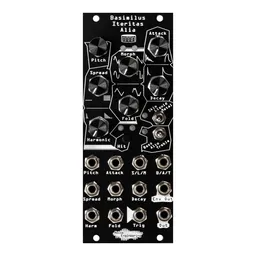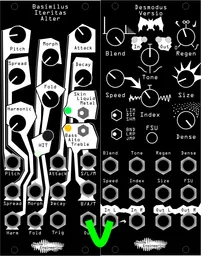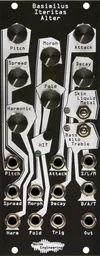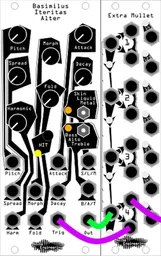Let’s be real here: getting a good mix in Eurorack can be difficult. Often, the only mixing utility you’ll see in a system is, well, a mixer. Investing the space needed for a full channel with EQ and compression per instrument isn’t always worth it (but don’t let me stop you if you have the space). So what can we do? Let’s talk about a few techniques that can help your patches sound clearer using modules you may already have in your system.
Frequency balance and emphasis with distortion
I like to think of sounds as belonging to three different “layers”: high-frequency stuff (like hats, noise, and high-pitched instruments), mid-range things (like snares, toms, and most synth voices), and low end (kicks and bass). Getting things to stay in only that range can be a bit of a challenge, but distortion can actually help. Let’s take an acid synth line as an example. That’s a sound that has a pretty huge frequency range.
Distortion is a great tool for managing this: depending on where you want it to sit relative to other sounds, you can run it through different types of distortion to emphasize low end and mellow out some highs, or reduce the low end to have it sit on top of your bass. In fact, Terci Ruina is a great module for this: the FB circuit is bassy and brings down a lot of high end, and the FZ circuit brings a lot of high frequency content to the front. An acid bassline is a fantastic candidate for this since it’s something we’d distort anyway, but I also really like it for snares: many synthesized snares have a lot of low end, and we don’t always want that, since it can interfere with our kick.
Here’s an example. Check out the dry mix:
And here, we’ve applied the FZ distortion from TR to the bassline. Hear how it’s a lot more present?
Distortion to the rescue! When using a heavy distortion like TR, though, it can become too much really fast. Maybe we don’t want that character so much in our mix. What if we could balance this technique out somehow?
Learn more:
Parallel processing
This is something that’s used a lot in traditional mixing, most often with compression (that’s what New York-style compression is, if you’ve ever heard that term thrown around) but it’s great for other things too. It’s a simple concept: mix a dry, unprocessed signal with a heavily processed version for a new sound that keeps some of the original flavor but still has, for instance, the transient emphasis that comes from heavy compression.
This is a mixing technique that’s often easier to patch than it is to actually set up in a session, funnily enough, and we have all sorts of effects in Eurorack that aren’t common in a traditional studio.
There are dedicated dry/wet modules we can use for this (I like the WMD AXYS a lot) but you can also just use a mult and a mixer. Split your signal with the mult, run one copy through, for instance, the FZ circuit on your TR, and mix it with the untouched copy in your mixer. Find a balance that you like, and you’re off. Here’s what that patch would look like:
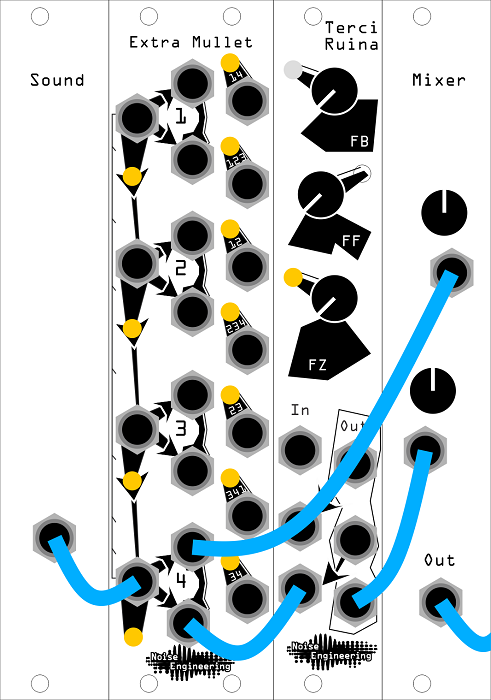
I do this a lot with my compressors, but distortion is another great use, along with pretty much any other effect you can think of. Here’s an example using the same patch as before: we’ve got the distortion mixed with the dry signal, and we created a balance using a crossfader. This is my favorite version: not too distorted, but still lots of character and presence:
Less is more: reverb and delay and processing
While it can sound awesome to run a whole mix through reverb, this often reduces the amount of impact individual elements have. If something feels diffuse or it doesn’t have enough punch, try reducing any reverb you have applied. When I mix, I tend to only run a couple of elements through reverb/delay, and leave the stuff I want to be punchy and in-your-face completely dry. It’s worth experimenting with, as the first time I turned the reverb off in a mix just to see what it would sound like I was pretty shocked at how present everything felt.
I also recommend running delays and reverbs through highpass filters. You often don’t need low end, and low end in reverb often makes other things sound muddy. It can help clean up a mix A LOT.
Experiment!
Mixing, like anything else in music, can be creative. Find the techniques that you like that work for your individual sound. Experimentation pays off, and you sometimes find things that help with composition, too!
